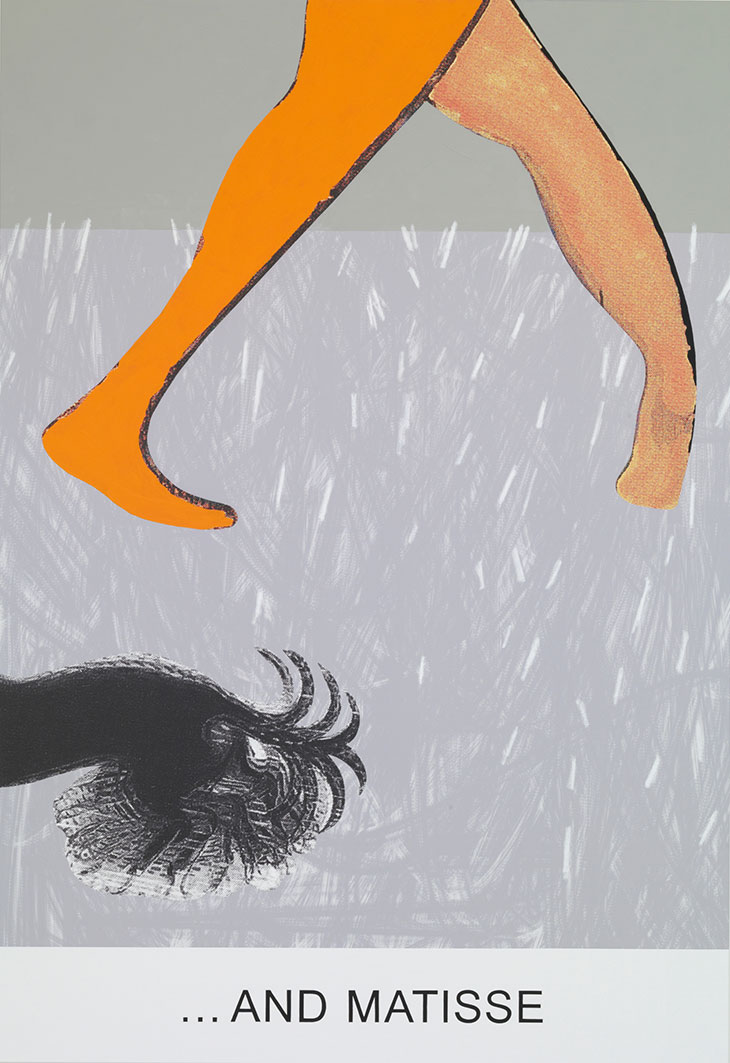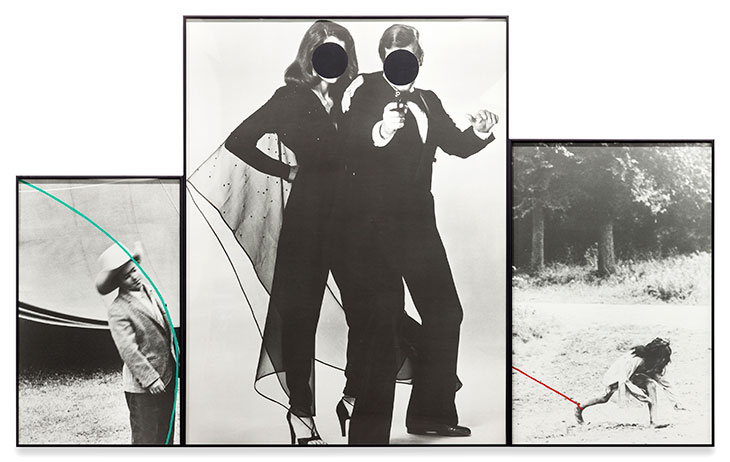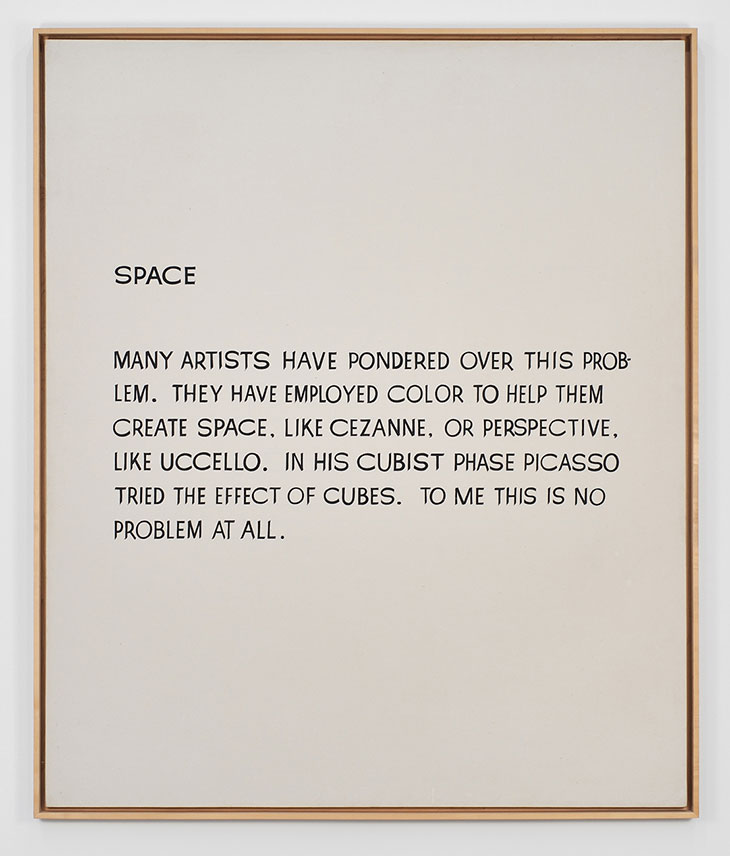John Baldessari was one of the inventors of conceptual art. He overlaid an ironic, southern California attitude on to what had largely been a rather dry, intellectual endeavour. Although he abandoned painting in the late ’60s, John never relinquished the retinal component of art. His work combined visual directness with diamond-hard wit. The two artists who exerted the greatest influence on his own art were Duchamp and Matisse.

Double Bill: …And Matisse (2012), John Baldessari. Courtesy the artist and Marian Goodman Gallery New York, Paris and London; © John Baldessari
I met John in 1970 as a freshman at the newly opened California Institute of the Arts, where he was my teacher and mentor. We became friends and remained so until the end. John’s class was called ‘Post-studio Art’, which meant anything other than painting. He taught by example: this is what an artist does, this is how they go about finding a subject, it’s a way of life. John’s role was not to explain, but to witness and to do. Our job as students was primarily to keep John amused.
John treated his students like colleagues; we were also his helpers. Students were recruited for John’s early video and photomontage pieces, on both sides of the camera. Working for John was hands-on and pragmatic – we saw art being made in real time.

Bond (1988), John Baldessari. Courtesy the artist and Sprüth Magers; © John Baldessari
John had worked his way up from humble beginnings, teaching high school art classes in San Diego before moving to Santa Monica and leading the charge at Cal Arts. Staggeringly well read, John was a very worldly person camouflaged as a modest everyman. His wit was lightening fast, and could be devastating. Almost single-handedly, he took the Los Angeles art world out of its provincialism and on to the world stage.
John used a pictorial syntax to pose abstract philosophical questions about meaning and certainty; he was a doubter, mistrustful of absolutes. His work could be puzzling or even obscure, but as he got older, John’s background as a painter reasserted itself, and his work became more visually lush. His later-life success was such that he became one of a handful of names recognised beyond the art world. John’s word paintings of the late 1960s and early ’70s look ravishing today. His influence is vast and will likely continue to grow.

Space (1966–68), John Baldessari. Courtesy the artist and Marian Goodman Gallery New York, Paris and London; © John Baldessari
Meeting John when I did – I was 18 – was a great stroke of good luck; it’s hard to imagine what my life would have been had I not met him. He encouraged the long view, and nothing human surprised him. He used to tell me, ‘Art is long, and so is life.’ When discussing possible dealers to work with, he advised finding one who was likeable. ‘You actually have to spend time with them, so you might as well enjoy it.’ It was another instance of teaching by example.
John was an enormously important artist who wore it very lightly. I never saw him misplace his sense of humour, or his humanity, even with the demands of his large and growing fame. I used to get postcards from him (as many others did) when he was travelling for shows. I have one sent from Australia just signed ‘Kang-Guru’.
An exhibition of new paintings by David Salle opens at Galerie Thaddaeus Ropac, Paris, on 25 January.

‘He taught by example’ – a tribute to John Baldessari (1931–2020)
John Baldessari photographed in 2015. Photo: courtesy Manfredi Gioacchini
Share
John Baldessari was one of the inventors of conceptual art. He overlaid an ironic, southern California attitude on to what had largely been a rather dry, intellectual endeavour. Although he abandoned painting in the late ’60s, John never relinquished the retinal component of art. His work combined visual directness with diamond-hard wit. The two artists who exerted the greatest influence on his own art were Duchamp and Matisse.
Double Bill: …And Matisse (2012), John Baldessari. Courtesy the artist and Marian Goodman Gallery New York, Paris and London; © John Baldessari
I met John in 1970 as a freshman at the newly opened California Institute of the Arts, where he was my teacher and mentor. We became friends and remained so until the end. John’s class was called ‘Post-studio Art’, which meant anything other than painting. He taught by example: this is what an artist does, this is how they go about finding a subject, it’s a way of life. John’s role was not to explain, but to witness and to do. Our job as students was primarily to keep John amused.
John treated his students like colleagues; we were also his helpers. Students were recruited for John’s early video and photomontage pieces, on both sides of the camera. Working for John was hands-on and pragmatic – we saw art being made in real time.
Bond (1988), John Baldessari. Courtesy the artist and Sprüth Magers; © John Baldessari
John had worked his way up from humble beginnings, teaching high school art classes in San Diego before moving to Santa Monica and leading the charge at Cal Arts. Staggeringly well read, John was a very worldly person camouflaged as a modest everyman. His wit was lightening fast, and could be devastating. Almost single-handedly, he took the Los Angeles art world out of its provincialism and on to the world stage.
John used a pictorial syntax to pose abstract philosophical questions about meaning and certainty; he was a doubter, mistrustful of absolutes. His work could be puzzling or even obscure, but as he got older, John’s background as a painter reasserted itself, and his work became more visually lush. His later-life success was such that he became one of a handful of names recognised beyond the art world. John’s word paintings of the late 1960s and early ’70s look ravishing today. His influence is vast and will likely continue to grow.
Space (1966–68), John Baldessari. Courtesy the artist and Marian Goodman Gallery New York, Paris and London; © John Baldessari
Meeting John when I did – I was 18 – was a great stroke of good luck; it’s hard to imagine what my life would have been had I not met him. He encouraged the long view, and nothing human surprised him. He used to tell me, ‘Art is long, and so is life.’ When discussing possible dealers to work with, he advised finding one who was likeable. ‘You actually have to spend time with them, so you might as well enjoy it.’ It was another instance of teaching by example.
John was an enormously important artist who wore it very lightly. I never saw him misplace his sense of humour, or his humanity, even with the demands of his large and growing fame. I used to get postcards from him (as many others did) when he was travelling for shows. I have one sent from Australia just signed ‘Kang-Guru’.
An exhibition of new paintings by David Salle opens at Galerie Thaddaeus Ropac, Paris, on 25 January.
Unlimited access from just $16 every 3 months
Subscribe to get unlimited and exclusive access to the top art stories, interviews and exhibition reviews.
Share
Recommended for you
John Baldessari gets the greatest accolade of them all – a guest turn on The Simpsons
Baldessari is the latest star to appear in The Simpsons – in a flashback scene with cub reporter Marge Simpson
David Salle puts a new spin on history painting
The painter’s witty and deceptively effortless works combine high and low culture to enjoyable effect
Etel Adnan (1925–2021)
In 2018, the Lebanese–American painter and poet talked to Apollo about her love of California and the difference between her painting and writing